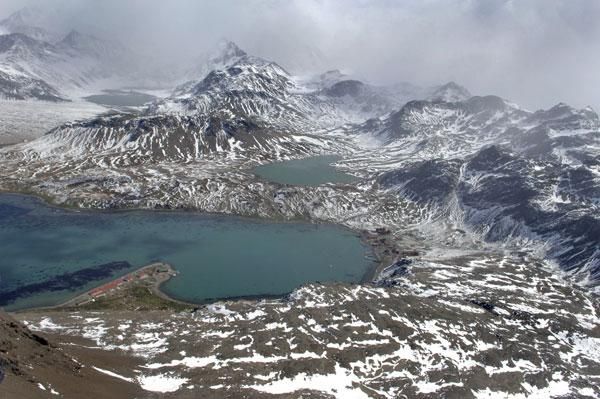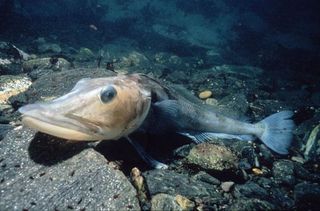
Island at Bottom of World Boasts Incredible Biodiversity

A sub-Antarctic island and its surrounding waters appear even richer in marine animal species than the legendary Galapagos Islands, scientists now reveal.
Investigators studied the marine biodiversity of South Georgia, an island about 105 miles (170 kilometers) long and more than three times the size of Hong Kong located in the Southern Ocean, the southernmost waters of the world's oceans .
"It looks like a giant has picked up the Alps and plonked them down in the middle of the Southern Ocean beautiful," said researcher Oliver Hogg, a marine ecologist with the British Antarctic Survey.
The new research has shown that the islands host hundreds of marine species, many found there and nowhere else. [Related: Images - Antarctica's Amazing Sea Life ]
Southern Ocean survey
The researchers conducted the first comprehensive study of sea creatures in the continental shelf area around South Georgia, a region covering about 17,000 square miles (44,000 square km). They analyzed more than 25,000 records dating back more than 130 years, collected from scientific cruises, fisheries vessels and by scuba divers from the seas around South Georgia.
"Last November, expert divers from the shallow marine survey group based in the Falkland Islands acted on our behalf to conduct the biggest exploration of South Georgian waters for 85 years," Hogg said. "Divers braved conditions of 0 degrees [Celsius] [32 degrees Fahrenheit] to collect samples from the northern waters of South Georgia."
Sign up for the Live Science daily newsletter now
Get the world’s most fascinating discoveries delivered straight to your inbox.
Their research found that South Georgia and its surrounding islands were the richest area for marine life in the Southern Ocean .
"Based on current data, South Georgia supports many more species than Galapagos and Ecuador combined," Hogg said. "During the breeding season, it hosts the densest mass of marine mammals on Earth."
Sea urchins, free-swimming worms, fish, sea spiders and crustaceans were among the 1,445 species recorded from the more than 17,000 specimens analyzed. Most are rare and many occur nowhere else on Earth.
This figure of 1,445 species is a conservative one. "Some estimates from marine species of South Georgia are well above 2,000," Hogg told OurAmazingPlanet.

Isolated island
The area is likely so diverse due to a combination of factors.
"The island is old it started separating from the South American landmass about 45 million years ago," Hogg said. "This has allowed life to develop here over a long time. Combined with this is that it is very isolated, enabling the evolution of new species."
In addition, the shelf area is large, offering diverse habitats and a big target for potential new colonists. Moreover, "South Georgia is in close proximity to nutrient-rich currents, which can also supply the island with both Antarctic and temperate species in the form of larvae or adults hitching a ride on kelp rafts."
At the same time, "the island so far seems to have no invasive marine species, allowing the natural community to develop undisturbed by aggressive invaders," Hogg said. Also, "it is too far north to experience significant ice scour, when an iceberg crashes along the sea floor, crushing much of the wildlife; it is too far south to experience too much human interaction."
When compared with one of its nearest neighbors, the South Orkney Islands, South Georgia's continental shelf is only 75 percent of the size but supports nearly 40 percent more species.
"In terms of other Southern Ocean islands, South Georgia also had the added benefit of not having its shelf completely covered during the last ice age," Hogg said. "As such, its wildlife has been able to colonize and evolve relatively undisturbed for longer than other islands.
Clues for conservation
These findings are key to monitor how these species might respond to future environmental changes. The near-surface waters around South Georgia are some of the fastest-warming on Earth, so this project will help identify ecologically sensitive areas and species as well as identify conservation priorities.
"This is the first time anybody has mapped out the biodiversity of a small polar archipelago in the Southern Ocean," Hogg said. "If we are to understand how these animals will respond to future change, a starting point like this is really important."
The biggest concern is likely to be the wholesale extinction of creatures there unable to cope with changes in their environment. Still, "we do not know with any certainty the ability of most of the species we report to deal with changing temperatures," Hogg noted. "Temperature in South Georgia's surface water can vary by as much as 5 degrees [Celsius] annually. As such, it is plausible that some South Georgian species have a predisposition to tolerating temperature change."
In the future, the researchers hope to map the South Georgian waters more completely. "Of prime interest is the area south of the island, which 'til now has received little attention," Hogg said. "This opens up the possibility of finding lots of new species."
The scientists detailed their findings online May 25 in the journal PLoS ONE.











